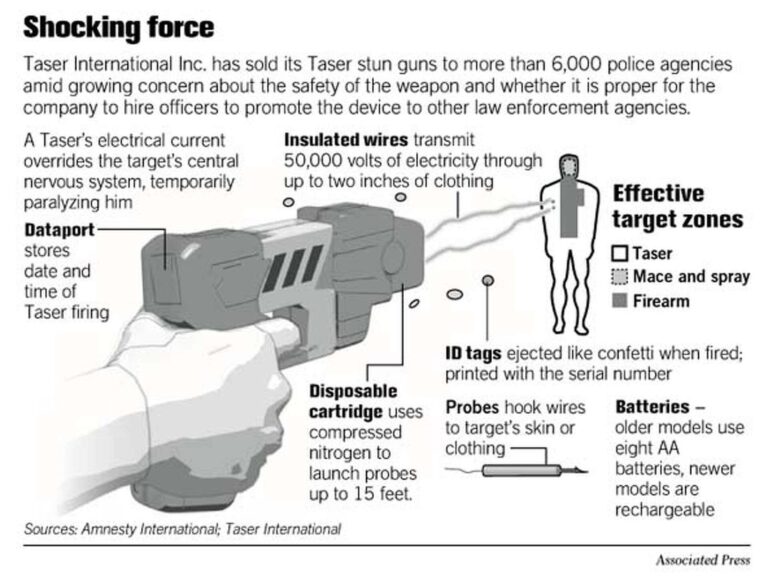Table of Contents
- Understanding the Electrical Mechanism Behind Stun Guns and Fire Hazards
- Materials and Conditions That Could Increase the Risk of Explosion with Stun Guns
- Safety Precautions to Prevent Accidental Fires When Using or Storing Stun Guns
- Expert Recommendations for Handling Stun Guns to Minimize Fire and Explosion Risks
- Key Takeaways
Understanding the Electrical Mechanism Behind Stun Guns and Fire Hazards
Stun guns operate by delivering a rapid, high-voltage, low-current electrical discharge designed to temporarily incapacitate a target through electrical shock. Unlike traditional firearms, their electrical mechanism relies on transforming a low-voltage battery input into a brief burst of up to tens of thousands of volts. This is achieved using a transformer and capacitor system within the device. However, the crucial factor to understand is that despite the high voltage, the current remains extremely low-measured in milliamperes-which significantly reduces the risk of causing thermal ignition or combustion. The device’s internal circuitry is engineered to prevent continuous current flow, thereby minimizing heat build-up that could potentially ignite nearby flammable substances.
While stun guns are generally safe in terms of fire hazards, certain conditions might, theoretically, increase risk. These include:
- Exposure to highly flammable gases or vapors, where an electrical spark-even a small one-could ignite an explosive environment.
- Physical damage or modification to the stun gun components, potentially causing electrical shorts that generate unwanted heat or sparks.
- Use of the device on or near combustible materials like gasoline containers or aerosol cans, where sparks could start a fire.
Materials and Conditions That Could Increase the Risk of Explosion with Stun Guns
While stun guns themselves are generally designed with safety features to minimize fire or explosion risks, certain environmental factors and materials can significantly elevate these dangers. Flammable gases, vapors, and liquids-such as propane, gasoline, or alcohol vapors-can ignite if exposed to the electric arc produced by a stun gun. Similarly, using or carrying a stun gun near volatile dust, like powdered metals or grain dust, may cause combustion due to the electrical discharge acting as an ignition source. Therefore, environments involving industrial solvents, fuel storage, or chemical manufacturing demand extreme caution when stun guns are nearby.
Additionally, the condition and quality of the stun gun itself play a pivotal role in explosion risks. Devices with damaged batteries, compromised insulation, or exposed wiring are more prone to short circuits that can lead to overheating, sparks, or fires. Storing stun guns improperly – for example, in excessively hot conditions or with other metallic objects that might cause unintended electrical contact – also raises hazards. Always ensure regular maintenance checks and avoid any use in hazardous atmospheres to minimize the chances of accidental explosive incidents.
Safety Precautions to Prevent Accidental Fires When Using or Storing Stun Guns
When handling stun guns, ensuring safety is paramount not only to prevent accidental shocks but also to avoid any fire hazards. Always store your device in a cool, dry place away from flammable materials such as papers, fabrics, or chemicals. Avoid exposing the stun gun to extreme temperatures or direct sunlight, as overheating can compromise the internal battery and increase fire risk. Additionally, never leave the stun gun fully charged and unattended for long periods; overcharging can lead to battery damage and potential thermal runaway.
Implementing proper usage habits dramatically reduces fire risks. Before activating your stun gun, confirm that it’s clear of any combustible items. Regularly inspect the device for signs of wear or damage, especially the battery compartment and wiring. When charging, use only the manufacturer’s recommended charger and ensure your hands are dry to avoid electrical shorts. Key safety tips include:
- Keep the stun gun away from children and unauthorized users.
- Store it in a dedicated case designed to insulate and protect the device.
- Use the stun gun strictly according to the manufacturer’s guidelines.
- Dispose of batteries responsibly and replace them as advised.
- Maintain regular inspections for corrosion or leakage around the battery area.
Expert Recommendations for Handling Stun Guns to Minimize Fire and Explosion Risks
To ensure the safe handling of stun guns and significantly reduce the risk of fire or explosion, experts emphasize the importance of proper storage and usage practices. Always keep the device away from flammable materials such as gasoline, aerosol sprays, or solvents. Avoid exposing the stun gun to excessive heat or direct sunlight, which can degrade the battery and increase the likelihood of malfunction. Regularly inspect the device for damage, corrosion, or signs of wear that could cause electrical shorts or sparks.
Experts also recommend the following precautions when operating a stun gun to maintain safety:
- Never use the stun gun near combustible gases or vapors.
- Charge batteries only with the manufacturer-approved charger, avoiding overcharging or using damaged cords.
- Handle the stun gun with dry hands to prevent electrical shock or unintended discharge.
- Store the device in a secure, temperature-controlled environment away from children and pets.
Key Takeaways
In conclusion, while stun guns are designed to deliver non-lethal electrical shocks for self-defense, the risk of them causing fire or explosions is extremely low under normal usage conditions. However, it’s important to follow manufacturer instructions carefully-avoid exposing the device to flammable substances, do not tamper with the internal components, and store it properly to minimize any potential hazards. By understanding how stun guns work and practicing responsible handling, you can confidently carry and use one as a safety tool without undue fear of fire or explosion. Stay informed, stay safe!Check Our Other Blogs
- StunGun – Your Trusted Source for Stun Guns, Laws, and Self-Defense Tips
- PepperSprayLaws – Your Trusted Resource for Pepper Spray Information
- StunGunLaws – Your Trusted Guide to Stun Gun Legality and Safety



